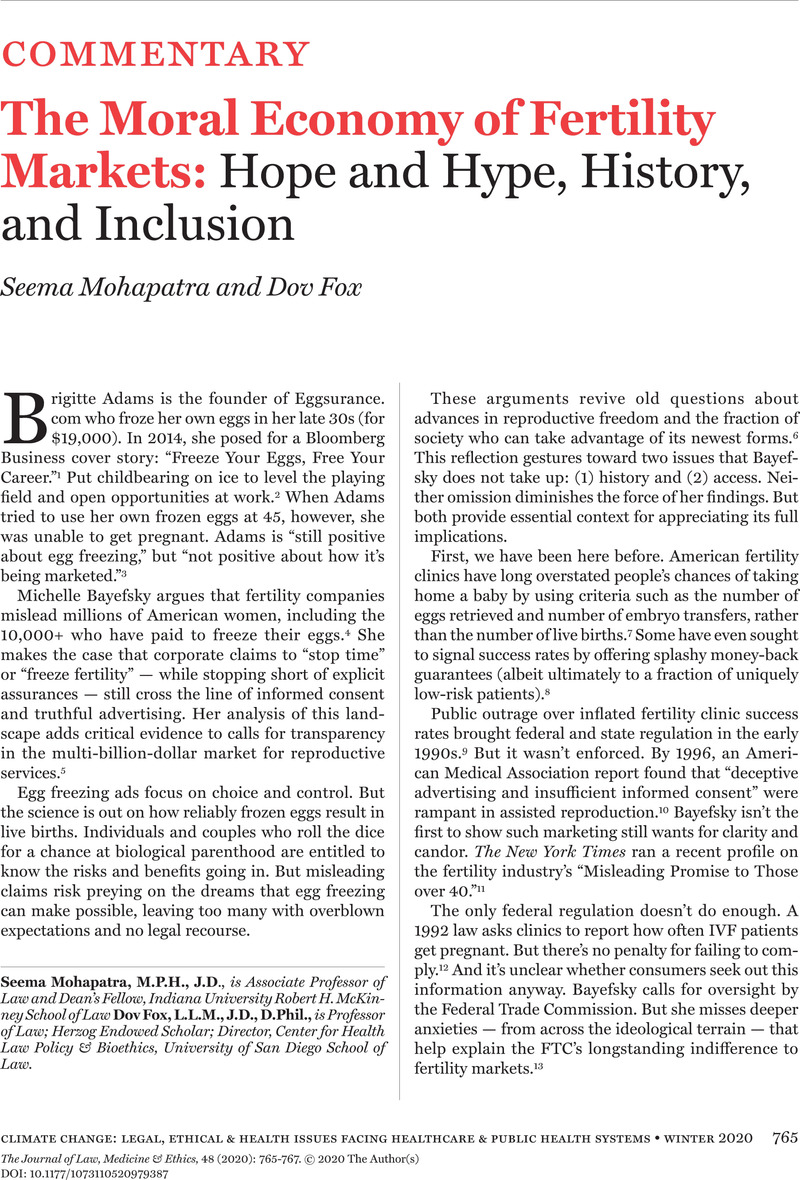No CrossRef data available.
Article contents
The Moral Economy of Fertility Markets: Hope and Hype, History, and Inclusion
Published online by Cambridge University Press: 27 January 2021
Abstract
An abstract is not available for this content so a preview has been provided. Please use the Get access link above for information on how to access this content.

- Type
- Independent Articles: Commentary
- Information
- Copyright
- Copyright © American Society of Law, Medicine and Ethics 2020
References
Friedman, D., “Perk Up: Facebook and Apple Now Pay for Women to Freeze
Eggs,” NBC News, October 14, 2014,
available at <https://www.nbcnews.com/news/us-news/perk-face-book-apple-now-pay-women-freeze-eggs-n225011>
(last visited October 9, 2020).+(last+visited+October+9,+2020).>Google Scholar
Mohapatra, S., “Using Egg Freezing to Extend the Biological
Clock: Fertility Insurance or False Hope”
Harvard Law & Policy Review
8, no. 2 (2014):
382–341.Google Scholar
Richards, S.E., “What Happened to All of Those Frozen Eggs?” New
York Times, December 21, 2019, available
at <https://www.nytimes.com/2019/12/21/opinion/sunday/egg-freezing-numbers.html>
(last visited October 9, 2020).+(last+visited+October+9,+2020).>Google Scholar
Bayefsky, M.J., “Legal and Ethical Analysis of Advertising for
Elective Egg Freezing,”
Journal of Law, Medicine & Ethics
48, no. 4 (2020):
748–764.Google Scholar
See, E.g., Carbone, J. and Madeira, J.L., “Buyers in the Baby Market: Toward a Transparent
Consumerism,”
Washington Law Review
91, no. 1 (2016):
71–107, at 77-79.Google Scholar
Hawkins, J., “Selling ART: An Empirical Assessment Of
Advertising On Fertility Clinics’ Websites,”
Indiana Law Journal
88, no. 4 (2013):
1147–1179, at 1169.Google Scholar
Wartik, N., “Making Babies: The Boom in the Infertility Business is Raising
Hopes, and Increasing Criticism,” Los Angeles Times
Magazine, March 6, 1994, at 18, 43, available
at <https://www.latimes.com/archives/la-xpm-1994-03-06-tm-30688-story.html>
(last visited October 9, 2020).+(last+visited+October+9,+2020).>Google Scholar
Schmittlein, D.C. and Morrison, D.G., “A Live Baby or Your Money Back: The Marketing of
In Vitro Fertilization Procedures,”
Management Science
49, no. 12 (2003):
1617–1635, at 1631.CrossRefGoogle Scholar
42 U.S.C. 263a-1 et. seq.
(2012).Google Scholar
American
Medical Association Council on Ethical & Judicial Affairs and Council
on Scientific Affairs, Issues of Ethical Conduct in
Assisted Reproductive Technology
2 (1996).Google Scholar
Brody, J.E., “I.V.F.’s Misleading Promise to Those over 40,”
New York Times, October 17, 2016,
available at <http://www.nytimes.com/2016/10/18/well/the-misleading-promise-of-ivffor-women-over-40.html>
(last visited October 9, 2020).+(last+visited+October+9,+2020).>Google Scholar
Industry guidelines are
supposed to be required for professional membership, but studies show that most
clinics face no penalty for claiming without evidence that they pregnancy
success rates are “superior” or “among the best.” Miller, W.K., “Assumption of What? Building Better Market
Architecture for Egg Donation,”
Tennessee Law Review
86, no. 1 (2018):
33–71, at
51–52; Abusief, M.E., Hornstein, M.D., and Jain, T., “Assessment of United States Fertility Clinic Websites According
to the American Society for Reproductive Medicine (ASRM) / Society for Assisted
Reproductive Technology (SART) guidelines,” Fertility and
Sterility 87, no. 1 (2007): 88–92.Google Scholar
On the right, for example, many
are anxious about implicitly endorsing technologies that separate sex from
reproduction. On the left, meanwhile, others are wary of opening the door to new
forms of reproductive restrictions on who gets to form families and how. See Fox, D., Birth Rights and Wrongs
(Oxford, 2019), at
29–30.Google Scholar
Mohapatra, S., “Fertility Preservation for Medical Reasons and
Reproductive Justice,”
Harvard Journal on Racial & Ethnic Justice
30, no. 1 (2014):
193–225, at 206
(2014).Google Scholar
Hoffower, H., “More Women are Freezing their Eggs to Delay Having Kids
— But the Process Costs Thousands of Dollars and Still Might not Work.
Here’s What You Should Know.” Business Insider,
January 15, 2020, available at <https://www.businessinsider.com/how-much-does-it-cost-to-freeze-your-eggs-2020-1>
(last visited October 9, 2020).+(last+visited+October+9,+2020).>Google Scholar
American Society for
Reproductive Medicine Access to Care Summit, (September 10-11,
2015) available at <https://www.asrm.org/globalassets/asrm/asrm-content/news-and-publications/news-and-research/press-releases-and-bulletins/pdf/atcwhitepaper.pdf>
(last visited October 9, 2020).+(last+visited+October+9,+2020).>Google Scholar
Allen, R., Is Egg Freezing Only for White Women?, New York Times,
May 21, 2016, available at <https://www.nytimes.com/2016/05/22/opinion/is-egg-freezing-only-for-white-women.html?smid=tw-share>
(last visited October 9, 2020); Ceballo, R., Graham, E.T., and Hart, J., “Silent and Infertile: An Intersectional Analysis
of the Experiences of Socioeconomically Diverse African American Women With
Infertility,”
Psychology of Women Quarterly
39, no. 4 (2015):
497–511, available at
<https://doi.org/10.1177/0361684315581169> (last visited
October 9, 2020).Google Scholar




